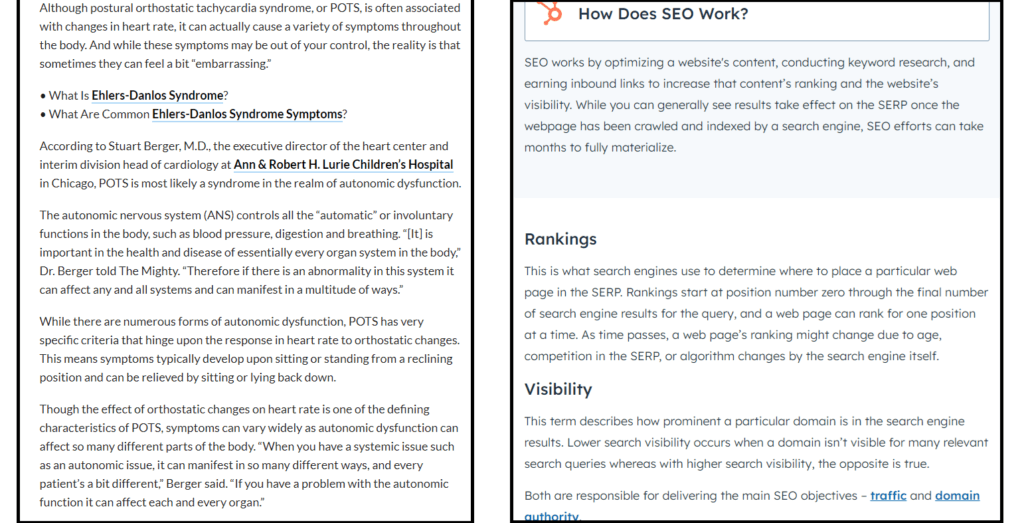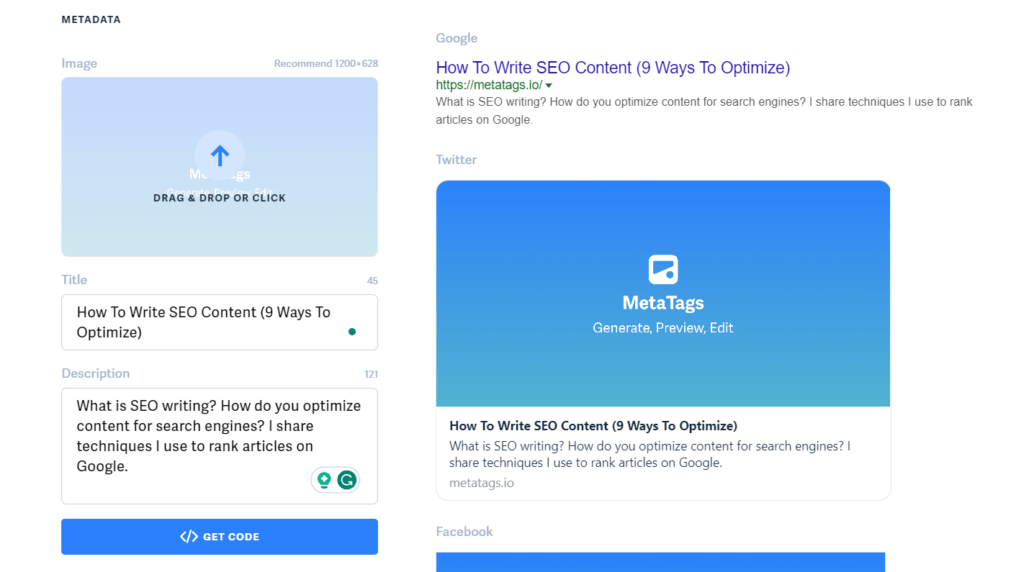Search engine optimization (SEO) has significantly evolved over the past several years. Yet, content remains an important theme in how Google decides which web pages deserve better ranking on the search results.
Google wants to serve billions of users with helpful content. Hence, SEO writing becomes a valuable skill for writers. Yet, some writers misunderstood SEO writing as merely filling an article with target keywords.
SEO writing goes beyond keyword optimization.
In this article, I’ll share what SEO writing is and how you can write in ways that Google and other search engines love.
What is SEO writing?
SEO writing is the practice of producing blogs, articles, landing pages, and other forms of web content in ways that improve their search visibility. In simpler terms, SEO writing allows a writer to deliver articles that rank for specific search phrases.
For example, you write a blog post about ‘how to learn digital marketing’. By applying SEO writing techniques, the article has a higher chance of ranking on Google. To do that, you apply a framework that helps search engines decide that your content provides the best value to search users.
Why is SEO writing important?
Over half of the global population uses search engines, underscoring why SEO is attractive to businesses. SEO is a cost-effective way to attract organic traffic, which they turn into revenue. Unlike paid advertisements, SEO-optimized webpages continue to draw search visitors over a long period.
In an effective SEO strategy, content is important in increasing search visibility. According to Google, content quality is more important than other ranking factors. For example, you can launch a link-building campaign to acquire more backlinks from authority publications. However, your web pages will not rank without purposeful and quality content.

SEO writing is highly influential in determining whether a webpage will eventually be visible on search engine result pages. Besides improving search visibility, SEO writing ensures that your audience gets what they search for when they land on your page. That’s the whole unchanging idea about SEO.
How do you write for SEO?
Many marketers assume that SEO writing is about focusing on keywords, adding meta descriptions, and meeting specific word counts. While those are tactical approaches to optimize web content for SEO crawlers, they are not fundamentals that support the long-term goals of search engines.
Rather, SEO writing produces content that meets the audience’s search intent. To break it down, consider the process users go through to acquire specific information on Google.
- Users enter a ‘search phrase’ on the search bar.
- Google seeks amongst billions of indexed web pages for the most relevant, useful, and quality content.
- Google lists the results according to their potential to answer the user’s query.
- The user reads the content.
Here, your task as an SEO writer is to present the information that readers seek in the most comprehensible manner. That’s why word counts, keyword density, and other on-page signals become secondary if you can’t provide useful content.
What is useful content?
Useful content focuses on humans and provides comprehensive information that answers the search intent. They contain unique viewpoints, personal stories, credible opinions, and other characteristics that separate your work from other web pages. Useful content is not an article you paraphrased from competitors.
Think about this. Would your content be useful if you were in the audience’s shoes? More importantly, would you trust what you wrote and use them to support your decisions?
These questions are relevant in SEO writing because they relate to a principle that Google uses to evolve its algorithm – EEAT. I’ll explain what EEAT is and how it relates to SEO writing below.
Understanding Google E-E-A-T
EEAT stands for Experience, Expertise, Authoritativeness, and Trustworthiness. They are qualitative indicators that Google uses to determine its algorithm’s performance. Ideally, Google wants to serve content that complies with all the aspects of EEAT and constantly adjusts its algorithm toward that direction.
Hence, it’s important to write in ways that align with what EEAT requires. The first ‘E” describes the experience reflected in the content. This means the author must be considerably experienced in a subject to write a convincing article.
For example, if you’re writing a review on an air fryer, Google assumes you’ve tried the product and not writing from the experience of others.
Google also wants the author to be an authority in their fields and demonstrate appropriate expertise in the content. That’s how publishers, writers, and brands build trust with their audience.
For example, a programmer writing about medical topics doesn’t align with the EEAT guideline because they were not professionally trained as healthcare experts.
So, be mindful of your style, choice of words, nuances, and correctness when you write about topics you’re not familiar with.
How to use SEO in Content Writing?
These are techniques I personally use to write content that performs well in search.
1. Write for humans
Instead of trying to manipulate Google’s SEO algorithm, focus on the audience you’re writing for. Your audience is humans capable of emotions and waiting to be engaged. Therefore, avoid monotonous styles or keyword stuffing meant to improve the ‘SEO score’.
Google has come a long way from its less-advanced self. It can sniff such attempts easily and push your web pages lower down the SERP.
Instead, focus on writing helpful articles that stand out from your competitors. Look for topics that were not addressed comprehensively and include them in your article. Be conversational when appropriate to convey your ideas effectively to the audience.
2. Use keywords naturally
Keyword stuffing is an archaic tactic that no longer works. In fact, Google considers such a practice spam and will penalize webpages violating its policy.
That said, keywords are still important in optimizing content, but you must use them naturally. Instead of stuffing specific keywords, write the entire content to provide information relevant to the primary search phrase.
Then, find opportunities to include related keywords in the article. I use SurferSEO to help me identify important keywords that may improve SEO results. Yet, avoid adding keywords just to hit the suggested number. If your content comprehensively covers the subject, it will likely contain most of the important keywords.
In general, I use the primary keyword
- Once in the Title.
- Once in the first 100 words.
- Once in the Heading.
3. Match the search intent
Remember that the whole idea of SEO is to give your readers what they’re searching for. Every SEO algorithm update that Google released gears toward this direction. It doesn’t matter if you have a fast-loading webpage or a strong backlink profile if you’re publishing irrelevant content.
For example, a blog post targeting “how to build a website” would contain detailed instructions about setting up a website, selecting themes, and publishing content. The blog wouldn’t rank well if it leans heavily toward promotional content, such as comparing top hosting providers.
There are several types of search intent that you must understand as an SEO writer.
- Informational. Phrases that help readers to learn more about a subject. (e.g., “What is SEO”, “How SEO works” )
- Transactional. Keywords that indicate an intent to buy. (e.g., “buy SEO course”, “SurferSEO promo code”).
- Commercial. Searches that help the audience make an informed decision before buying. (e.g., “Best SEO tools”, “SurferSEO review”)
- Navigational. Search phrases that help readers access specific web pages. (eg. “SurferSEO pricing”)
4. Add internal links
Internal links connect your content to other related pages on your website. They help readers access relevant information without leaving the website. Adding internal links also helps the search engine crawl and index those pages and boost topical authority.
As a rule, I add 3-4 internal links with appropriate anchor text to each blog article.
5. Link to authoritative sites
External links are similar to internal links, except that they point to pages on other websites. Adding external links is a good practice because it supplements your content with helpful information.
When adding external links, link to authoritative and reputable sites. This helps Google to interpret your content’s credibility and usability more favorably – potentially improving its ranking.
6. Add visuals
Visuals, such as infographics, videos, and checklists, help readers understand the content you write more easily.
For example, it’s difficult to explain the entire architecture of a machine learning model, but adding a simple diagram does the trick.

Likewise, a video explainer about performing yoga poses augments a blog post that helps beginners pick up yoga.
Moreover, people tend to share rich media content that engages them and proves helpful.
7. Use subheadings
Don’t drown your readers with chunks of text, particularly if you’re writing a difficult topic. Modern readers prefer skimmable content, and that means breaking your article down into several parts – with subheadings.
Use H2 to cover the main topics in the article and H3 and H4 to break them down further. Personally, I make it a habit to limit H2 to 300 words. Anything more than that calls for a new subheading.
Compare the articles below. Which one looks easier to read?

8. Optimize for readability
Readable content encourages users to stay on your page and search for the necessary information. Besides structuring the content with subheadings, here are several other methods.
- Use numbered or bullet lists to lay down related points you try to make.
- Use short sentences. Avoid cramping too many ideas into one sentence.
- Most readers serve the internet on mobile. Shorter paragraphs are more readable on small screens.
- Use simple words that the broader audience can easily understand.
Whether you’re optimizing for SEO or not, the above methods are useful when writing for online audiences.
9. Optimize title and meta descriptions
Google displays the page title on the search results. An interesting title attracts the audience to click on the page. And the resulting click-through rate may indirectly influence SEO ranking.

Meta description is not a direct SEO ranking factor. In fact, Google often replaces a site’s meta description with an excerpt from the content it thought to be more relevant.
That said, Google still occasionally shows meta descriptions, particularly for the homepage and service pages. Write a descriptive and compelling meta description to encourage users to click on your page.

Here’s a free tool I use to ensure I’m adhering to character limits for title and meta description.
Final Thoughts
SEO writing is important as more brands are seeking to strengthen their presence on search engines. While some tactics have changed, the guiding principle that enables brands to publish content that users love remains the same.
In short, Google reward content that proves helpful, answer the search intent and is free from manipulative elements. Do that, and you may find your articles eventually rise in the search ranking.
I hope that this guide proves useful to you. Share your thoughts in the comment below.

